动词+宾语+宾补
主语+及物动词+宾语+宾补举例
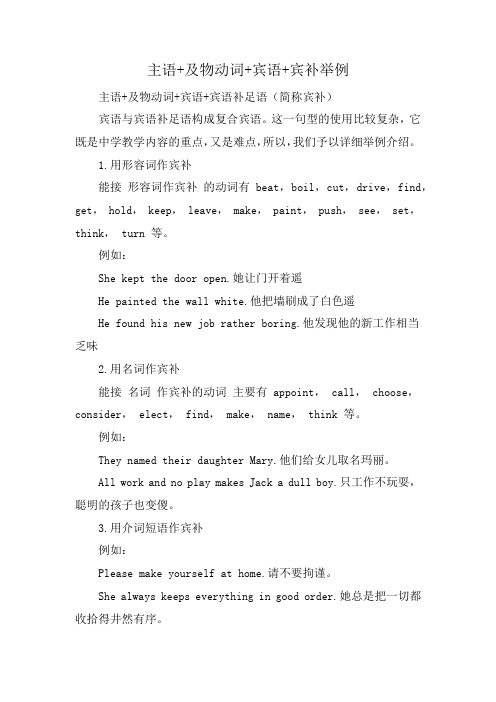
主语+及物动词+宾语+宾补举例主语+及物动词+宾语+宾语补足语(简称宾补)宾语与宾语补足语构成复合宾语。
这一句型的使用比较复杂,它既是中学教学内容的重点,又是难点,所以,我们予以详细举例介绍。
1.用形容词作宾补能接形容词作宾补的动词有 beat, boil, cut, drive, find,get, hold, keep, leave, make, paint, push, see, set,think, turn 等。
例如:She kept the door open.她让门开着遥He painted the wall white.他把墙刷成了白色遥He found his new job rather boring.他发现他的新工作相当乏味2.用名词作宾补能接名词作宾补的动词主要有 appoint, call, choose,consider, elect, find, make, name, think 等。
例如:They named their daughter Mary.他们给女儿取名玛丽。
All work and no play makes Jack a dull boy.只工作不玩耍,聪明的孩子也变傻。
3.用介词短语作宾补例如:Please make yourself at home.请不要拘谨。
She always keeps everything in good order.她总是把一切都收拾得井然有序。
I found her in better spirits when we met again.再见面时,我发现她的情绪好多了。
4.用副词作宾补例如:Don`t leave mebehind.别把我落下。
I won`t let youdown.我不会让你失望的。
Who will drive mehome? 谁开车把我送回家?5.用带to的不定式作宾补能接带to的不定式作宾补的动词主要有 advise, allow, ask,beg, cause, choose, encourage, expect, force, get, hate,invite, like, love, order,permit, persuade, prefer, request, teach, tell, want,warn, wish 等。
常考的动词宾语宾补结构

一、“ make宾语+xx”的用法“ make宾语+宾补”这一结构中,宾语补足语可以由名词、形容词、过去分词、不定式等来充当,例如:(1) A good friend is someone who makes you happy(. 形容词作宾补)(2) They made me repeat the story.(省to 的动词不定式)(3) He raised his voice to make himself heard过去分词作宾补)注:“ make宾语+宾补”结构中不用现在分词充当宾补。
(4) We made him monitor of our class.(名词作宾补)注:职务名词充当xx 补时其前面不要加冠词。
【试题链接】1. He is very popular among his students as he always tries to make them___ in his lectures.A.interestedB.interestingC.interestD.to interest2. Myparentshavealwaysmademe___aboutmyself,evenwhenIwastwelve.A.feeling wellB.feeling goodC.feel wellD.feel good答案:1. A2. D二、“ with宾语+xx”的用法“ with宾语+ 宾补”是高考试题中考查十分频繁的结构,“ with宾语+宾补”结构中的宾补主要有形容词、现在分词、过去分词、动词不定式等,在考题中常要求选择宾补的形式,在选择时宾补空间该使用什么形式,主要限决于宾语与宾补的关系,主动关系用现在分词,被动关系则用过去分词,此外,不定式作宾补要表示含义为将来的意味,例如:(2) With everything he need to buy, he went into the store. (不定式作宾补表示将来的含义)(3) With everything he need bought, he left the store. (过去分词作宾补表被动表完成)(4) With my key lost, I couldn ' t ente过m分词作宾补)(5) With nothing to do, I went out for a walk. (不定式作宾补)(6) I went out with the window open. ( 形容词作宾补)另外,“ with宾语+宾补”结构中还可由介词短语、副词短语来充当宾补,如:(1) She said good-bye with tears in her eyes.(2) He left the room with the light still on.试题链接】1. -- C ome on, please give me some ideas about the project. --- Sorry. With somuch work ___ my mind, I almost break down.A.filledB.fillingC.to fillD.being filled2. John received an invitation to dinner, and with his work ___ hegladly accepted it.A.finishedB.finishingC.having finishedD.was finished3. I couldn ' t to my homework with all the noise___.A.going onB.goes onC.went onD.to go on答案:1. B2. A3. A三、“ have宾语+xx”的用法在“have宾语+宾补”这一结构用法中,充当宾补的常用的有do, doing,done和adj,例如:(1) III have my hair cut this after n 我0今天下午要理发(2) I won ' t have you saying to your mother that way.(3) He reaIized that she did not wish to have her go with him.(4) I expect Amy wiII have the tea ready directIy.、/■ I ■ '。
宾补动词顺口溜

宾补动词顺口溜
宾语补足语是句中宾语的补充说明,一般与宾语搭配逻辑合理,语法正确,意思通顺。
以下是关于宾补动词的顺口溜,仅供参考:
1. 宾语补足语,切莫胡乱加,动词意思要表达清楚全靠它。
2. have/make/let/see/watch/notice/observe/hear/feel/listen to +宾语+宾补。
3. 动词不定式,有它没划线;to后啥都没,to后很自由。
4. to +及物动词变不定式。
5. 感官动词和使役动词接宾补,省略to来不忘记。
6. 动词原形前面加to,变成不定式。
7. to后接原形,to前加be done。
8. 一感二听三让四看半帮助,主动不能接to。
9. 若被to接通,条件和时间来帮忙。
10. 主从复合句,宾补须加从句中。
常见的加宾补的词有哪些
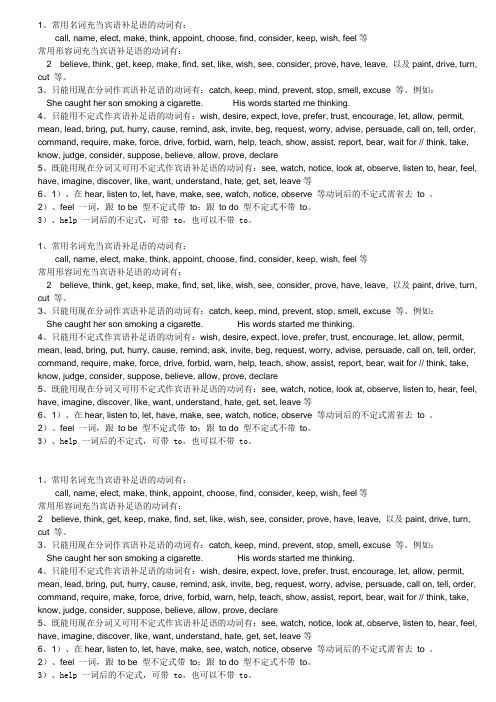
1、常用名词充当宾语补足语的动词有:call, name, elect, make, think, appoint, choose, find, consider, keep, wish, feel等常用形容词充当宾语补足语的动词有:2 believe, think, get, keep, make, find, set, like, wish, see, consider, prove, have, leave, 以及paint, drive, turn, cut 等。
3、只能用现在分词作宾语补足语的动词有:catch, keep, mind, prevent, stop, smell, excuse 等。
例如:She caught her son smoking a cigarette. His words started me thinking.4、只能用不定式作宾语补足语的动词有:wish, desire, expect, love, prefer, trust, encourage, let, allow, permit, mean, lead, bring, put, hurry, cause, remind, ask, invite, beg, request, worry, advise, persuade, call on, tell, order, command, require, make, force, drive, forbid, warn, help, teach, show, assist, report, bear, wait for // think, take, know, judge, consider, suppose, believe, allow, prove, declare5、既能用现在分词又可用不定式作宾语补足语的动词有:see, watch, notice, look at, observe, listen to, hear, feel, have, imagine, discover, like, want, understand, hate, get, set, leave等6、1)、在hear, listen to, let, have, make, see, watch, notice, observe 等动词后的不定式需省去to 。
“动词+宾语+宾语补足语”结构

“动词+宾语+宾语补足语”结构
再看使役动词主动结构的用法:have sb. do/ doing/ done, make/let sb. do/ done have后也接do(省to)/ doing/ done作宾补,区别是:
1)do/ doing 均表主动关系,done表被动关系。 2)do/ doing虽然都表主动,但do指目前和将来或经常性、 反复性的动作。doing指目前正在进行的动作。
We found a cat lying under the chair. (现在分词短语作宾补,表主动、正在进行) 我们发现有一只猫躺在那把椅子下面。
The little girl often help her mother (to) do the housework. (带to或不带to的动词不定式作宾补) 这个小女孩经常帮她的 母亲做家务活。
“动词+宾语+宾语补足语”结构
【二、温馨提示】
1.接名词作宾语补足语的动词常见的有: call, think, elect, choose, consider, point等。 People call me Xiao Li. 人们称我小李。 We elected / made him our monitor. 我们选他当班长。
3)make/let与have的用法有点不同,make/let后一般不接 doing作宾补。相比之下,make/let sb. do/done的用法就简单 得多了。区别就是:do(省to)表示主动,done表示被动。
“动词+宾语+宾语补足语”结构
【三、习题练习】
1、The speaker raised his voice but still couldn’t make himself
常考的动词+宾语+宾补结构
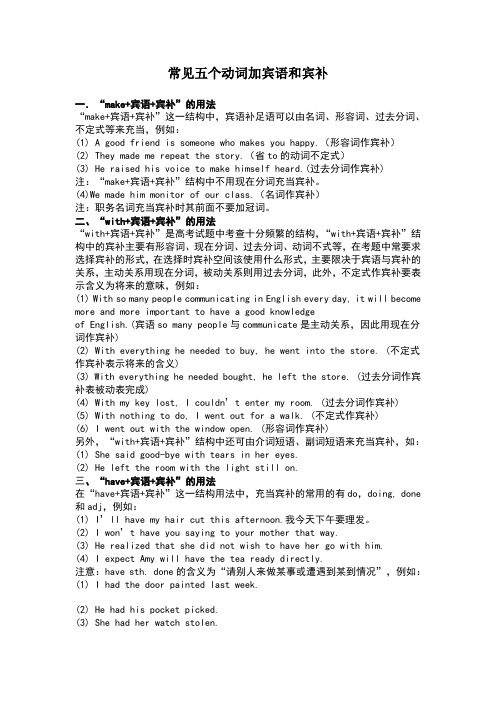
常见五个动词加宾语和宾补一.“make+宾语+宾补”的用法“make+宾语+宾补”这一结构中,宾语补足语可以由名词、形容词、过去分词、不定式等来充当,例如:(1) A good friend is someone who makes you happy.(形容词作宾补)(2) They made me repeat the story.(省to的动词不定式)(3) He raised his voice to make himself heard.(过去分词作宾补)注:“make+宾语+宾补”结构中不用现在分词充当宾补。
(4)We made him monitor of our class.(名词作宾补)注:职务名词充当宾补时其前面不要加冠词。
二、“with+宾语+宾补”的用法“with+宾语+宾补”是高考试题中考查十分频繁的结构,“with+宾语+宾补”结构中的宾补主要有形容词、现在分词、过去分词、动词不式等,在考题中常要求选择宾补的形式,在选择时宾补空间该使用什么形式,主要限决于宾语与宾补的关系,主动关系用现在分词,被动关系则用过去分词,此外,不定式作宾补要表示含义为将来的意味,例如:(1) With so many people communicating in English every day, it will become more and more important to have a good knowledgeof English.(宾语so many people与communicate是主动关系,因此用现在分词作宾补)(2) With everything he needed to buy, he went into the store. (不定式作宾补表示将来的含义)(3) With everything he needed bought, he left the store. (过去分词作宾补表被动表完成)(4) With my key lost, I couldn’t enter my room. (过去分词作宾补)(5) With nothing to do, I went out for a walk. (不定式作宾补)(6) I went out with the window open. (形容词作宾补)另外,“with+宾语+宾补”结构中还可由介词短语、副词短语来充当宾补,如:(1) She said good-bye with tears in her eyes.(2) He left the room with the light still on.三、“have+宾语+宾补”的用法在“have+宾语+宾补”这一结构用法中,充当宾补的常用的有do,doing, done 和adj,例如:(1) I’ll have my hair cut this afternoon.我今天下午要理发。
常考的动词宾语宾补结构
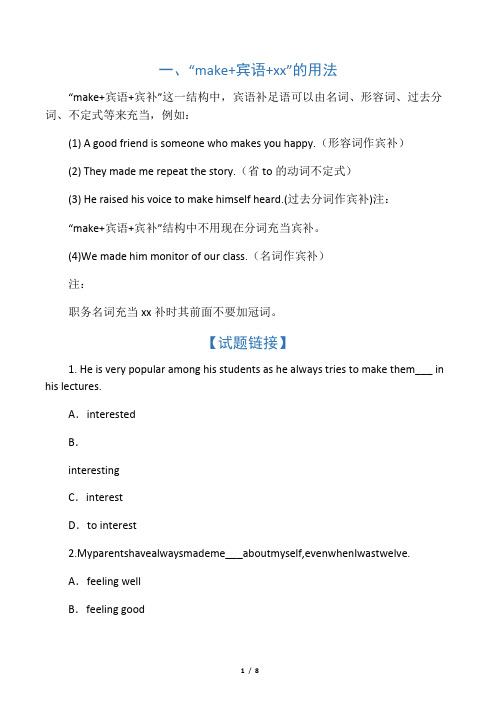
一、“make+宾语+xx”的用法“make+宾语+宾补”这一结构中,宾语补足语可以由名词、形容词、过去分词、不定式等来充当,例如:(1) A good friend is someone who makes you happy.(形容词作宾补)(2) They made me repeat the story.(省to的动词不定式)(3) He raised his voice to make himself heard.(过去分词作宾补)注:“make+宾语+宾补”结构中不用现在分词充当宾补。
(4)We made him monitor of our class.(名词作宾补)注:职务名词充当xx补时其前面不要加冠词。
【试题链接】1. He is very popular among his students as he always tries to make them___ in his lectures.A.interestedB.interestingC.interestD.to interest2.Myparentshavealwaysmademe___aboutmyself,evenwhenIwastwelve.A.feeling wellB.feeling goodC.feel wellD.feel good答案:1.A2.D二、“with+宾语+xx”的用法“with+宾语+宾补”是高考试题中考查十分频繁的结构,“with+宾语+宾补”结构中的宾补主要有形容词、现在分词、过去分词、动词不定式等,在考题中常要求选择宾补的形式,在选择时宾补空间该使用什么形式,主要限决于宾语与宾补的关系,主动关系用现在分词,被动关系则用过去分词,此外,不定式作宾补要表示含义为将来的意味,例如:(2) With everything he need to buy, he went into the store. (不定式作宾补表示将来的含义)(3) With everything he need bought, he left the store. (过去分词作宾补表被动表完成)(4) With my key lost, I couldn’t enter my room. (过去分词作宾补)(5) With nothing to do, I went out for a walk. (不定式作宾补)(6) I went out with the window open. (形容词作宾补)另外,“with+宾语+宾补”结构中还可由介词短语、副词短语来充当宾补,如:(1) She said good-bye with tears in her eyes.(2) He left the room with the light still on.【试题链接】1. ----Come on, please give me some ideas about the project.----Sorry. With so much work ___ my mind, I almost break down.A.filledB.fillingC.to fillD.being filled2. John received an invitation to dinner, and with his work ___ hegladly accepted it.A.finishedB.finishingC.having finishedD.was finished3. I couldn’t to my homework with all the noise___.A.going onB.goes onC.went onD.to go on答案:1. B2. A3. A三、“have+宾语+xx”的用法在“have+宾语+宾补”这一结构用法中,充当宾补的常用的有do,doing,done 和adj,例如:(1) I’ll have my hair cut this afternoon.我今天下午要理发。
宾语补足知识点总结

宾语补足知识点总结一、宾语补足语(宾补)宾语补足语(宾补)是指在及物动词后所需的宾语后面,充当宾语补足的成分,通常由名词、形容词或动词不定式构成。
宾补通常有以下几种类型:1. 名词宾语补足语:通常由名词、代词、数词等构成。
例如:I consider him (to be) my friend.(我认为他是我的朋友。
)2. 形容词宾语补足语:通常由形容词构成。
例如:They found the film (interesting).(他们觉得那部电影很有趣。
)3. 动词不定式宾语补足语:通常由动词不定式构成。
例如:I wanted (to go) there.(我想去那里。
)二、宾语补足成分(宾补成分)宾语补足成分(宾补成分)是指在及物动词后所需的宾语之后,作为宾语补足的成分,通常由名词、代词、形容词或动词不定式构成。
宾补成分的构成形式和用法与宾补基本相同。
三、宾语补足的构成形式宾语补足的构成形式包括:名词补语、形容词补语、副词补语和动词不定式补语。
其中,名词补语、形容词补语和动词不定式补语是比较常见的形式,而副词补语出现的频率较低。
四、宾语补足的用法1. 宾语补足的用法主要包括以下几个方面:(1)表示动作的结果或状态:通常由形容词或动词不定式构成。
例如:He made me (angry).(他惹怒了我。
)(2)表示宾语的补充说明:用于对宾语进行补充或说明。
例如:I find the book (interesting).(我觉得这本书很有趣。
)(3)表示动词的意义:通常由动词不定式构成。
例如:I saw him (go out).(我看见他走出去了。
)2. 在实际应用中,宾语补足通常需符合以下几个原则:(1)宾语补足通常应与及物动词构成逻辑上的完整意思。
(2)宾语补足通常应与及物动词一起构成句子的谓语动词。
(3)宾语补足通常应与及物动词构成合理的语法结构。
五、宾语补足的误用在英语中,有些人容易在使用宾语补足时出现误用。
6大使役动词的用法记忆口诀
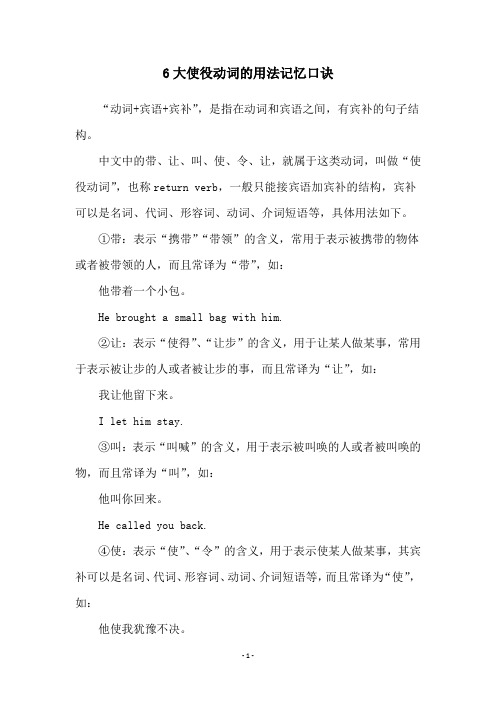
6大使役动词的用法记忆口诀“动词+宾语+宾补”,是指在动词和宾语之间,有宾补的句子结构。
中文中的带、让、叫、使、令、让,就属于这类动词,叫做“使役动词”,也称return verb,一般只能接宾语加宾补的结构,宾补可以是名词、代词、形容词、动词、介词短语等,具体用法如下。
①带:表示“携带”“带领”的含义,常用于表示被携带的物体或者被带领的人,而且常译为“带”,如:他带着一个小包。
He brought a small bag with him.②让:表示“使得”、“让步”的含义,用于让某人做某事,常用于表示被让步的人或者被让步的事,而且常译为“让”,如:我让他留下来。
I let him stay.③叫:表示“叫喊”的含义,用于表示被叫唤的人或者被叫唤的物,而且常译为“叫”,如:他叫你回来。
He called you back.④使:表示“使”、“令”的含义,用于表示使某人做某事,其宾补可以是名词、代词、形容词、动词、介词短语等,而且常译为“使”,如:他使我犹豫不决。
He made me hesitate.⑤令:与使用法类似,不过常译为“令”,如:令他感到担忧。
Make him worried.⑥让:表示“让”的含义,用于表示让某人做某事,其宾补可以是名词、代词、形容词、动词、介词短语等,而且常译为“让”,如:我让他们同意。
I made them agree.以上就是6大使役动词的用法。
在使用这6种动词时,我们应该注意以下几点:一是使役动词常跟宾补,宾补可以是名词、代词、形容词、动词、介词短语等;二是使役动词常以祈使句的语气表达,如果后面宾补不是动词,那么后面的宾补用to do的形式;三是使役动词的译法结构常常是“动词+宾语+宾补”,应该重视使役动词的宾补,做到准确把握;四是使役动词的否定形式常常是“不要+动词+宾语+宾补”。
通过以上介绍,我们就可以记住、掌握6大使役动词的用法了。
只有掌握了使役动词的正确用法,我们才能在英语学习和使用中更准确地表达自己的意思。
常考的动词+宾语+宾补结构
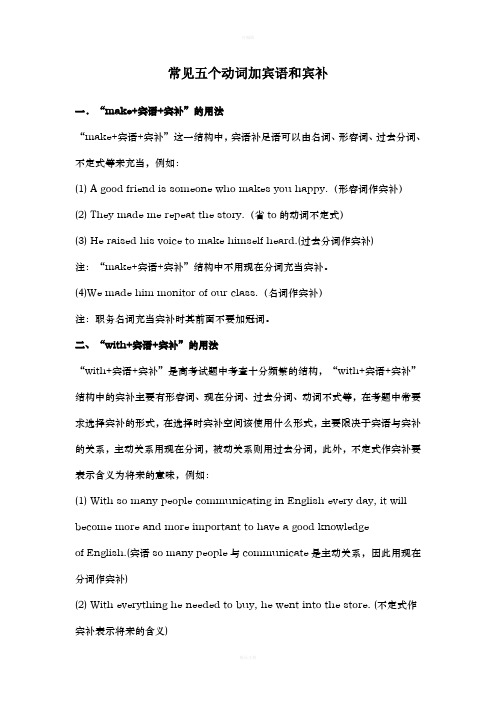
常见五个动词加宾语和宾补一.“make+宾语+宾补”的用法“make+宾语+宾补”这一结构中,宾语补足语可以由名词、形容词、过去分词、不定式等来充当,例如:(1) A good friend is someone who makes you happy.(形容词作宾补)(2) They made me repeat the story.(省to的动词不定式)(3) He raised his voice to make himself heard.(过去分词作宾补)注:“make+宾语+宾补”结构中不用现在分词充当宾补。
(4)We made him monitor of our class.(名词作宾补)注:职务名词充当宾补时其前面不要加冠词。
二、“with+宾语+宾补”的用法“with+宾语+宾补”是高考试题中考查十分频繁的结构,“with+宾语+宾补”结构中的宾补主要有形容词、现在分词、过去分词、动词不式等,在考题中常要求选择宾补的形式,在选择时宾补空间该使用什么形式,主要限决于宾语与宾补的关系,主动关系用现在分词,被动关系则用过去分词,此外,不定式作宾补要表示含义为将来的意味,例如:(1) With so many people communicating in English every day, it will become more and more important to have a good knowledgeof English.(宾语so many people与communicate是主动关系,因此用现在分词作宾补)(2) With everything he needed to buy, he went into the store. (不定式作宾补表示将来的含义)(3) With everything he needed bought, he left the store. (过去分词作宾补表被动表完成)(4) With my key lost, I couldn’t enter my room. (过去分词作宾补)(5) With nothing to do, I went out for a walk. (不定式作宾补)(6) I went out with the window open. (形容词作宾补)另外,“with+宾语+宾补”结构中还可由介词短语、副词短语来充当宾补,如:(1) She said good-bye with tears in her eyes.(2) He left the room with the light still on.三、“have+宾语+宾补”的用法在“have+宾语+宾补”这一结构用法中,充当宾补的常用的有do,doing, done 和adj,例如:(1) I’ll have my hair cut this afternoon.我今天下午要理发。
接现在分词作宾补的20个动词
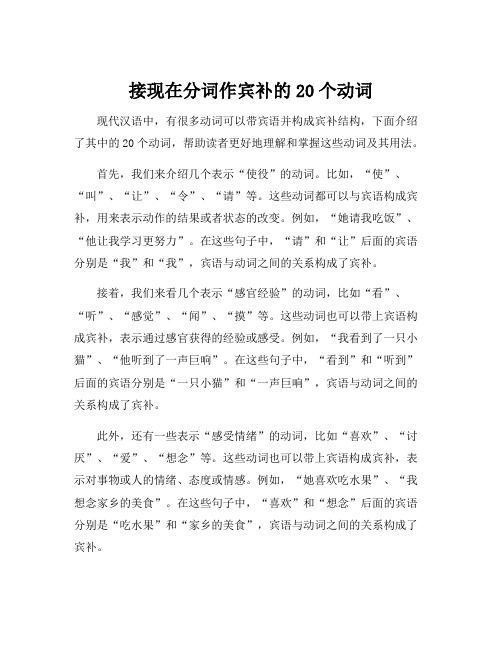
接现在分词作宾补的20个动词现代汉语中,有很多动词可以带宾语并构成宾补结构,下面介绍了其中的20个动词,帮助读者更好地理解和掌握这些动词及其用法。
首先,我们来介绍几个表示“使役”的动词。
比如,“使”、“叫”、“让”、“令”、“请”等。
这些动词都可以与宾语构成宾补,用来表示动作的结果或者状态的改变。
例如,“她请我吃饭”、“他让我学习更努力”。
在这些句子中,“请”和“让”后面的宾语分别是“我”和“我”,宾语与动词之间的关系构成了宾补。
接着,我们来看几个表示“感官经验”的动词,比如“看”、“听”、“感觉”、“闻”、“摸”等。
这些动词也可以带上宾语构成宾补,表示通过感官获得的经验或感受。
例如,“我看到了一只小猫”、“他听到了一声巨响”。
在这些句子中,“看到”和“听到”后面的宾语分别是“一只小猫”和“一声巨响”,宾语与动词之间的关系构成了宾补。
此外,还有一些表示“感受情绪”的动词,比如“喜欢”、“讨厌”、“爱”、“想念”等。
这些动词也可以带上宾语构成宾补,表示对事物或人的情绪、态度或情感。
例如,“她喜欢吃水果”、“我想念家乡的美食”。
在这些句子中,“喜欢”和“想念”后面的宾语分别是“吃水果”和“家乡的美食”,宾语与动词之间的关系构成了宾补。
此外,还有一些表示“感受情绪”的动词,比如“喜欢”、“讨厌”、“爱”、“想念”等。
这些动词也可以带上宾语构成宾补,表示对事物或人的情绪、态度或情感。
例如,“她喜欢吃水果”、“我想念家乡的美食”。
在这些句子中,“喜欢”和“想念”后面的宾语分别是“吃水果”和“家乡的美食”,宾语与动词之间的关系构成了宾补。
最后,还有一些表示“认为”、“称呼”等意义的动词,比如“认为”、“称为”、“称作”等。
这些动词也可以带上宾语构成宾补,表示对事物的定义、描述或判断。
例如,“我认为这个问题很重要”、“他被称为钢琴家中的奇才”。
在这些句子中,“认为”和“称为”后面的宾语分别是“这个问题很重要”和“钢琴家中的奇才”,宾语与动词之间的关系构成了宾补。
跟双宾语及宾补结构的动词
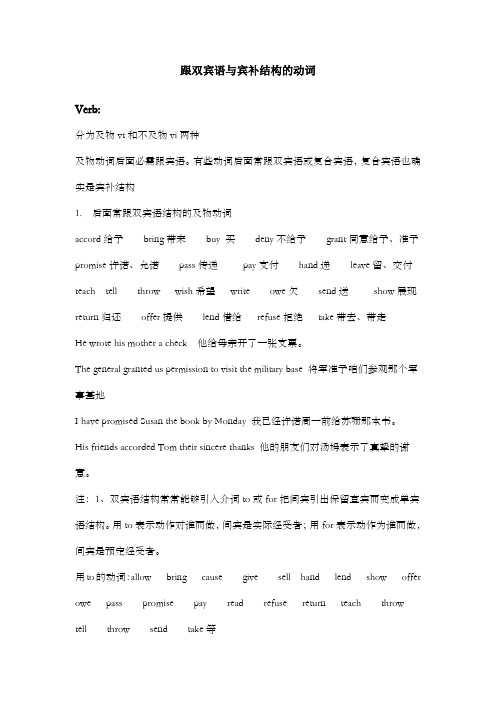
跟双宾语与宾补结构的动词Verb:分为及物vt和不及物vi两种及物动词后面必需跟宾语。
有些动词后面常跟双宾语或复合宾语,复合宾语也确实是宾补结构1.后面常跟双宾语结构的及物动词accord给予bring带来buy 买deny不给予grant同意给予、准予promise许诺、允诺pass传递pay支付hand递leave留、交付teach tell throw wish希望write owe欠send送show展现return归还offer提供lend借给refuse拒绝take带去、带走He wrote his mother a check 他给母亲开了一张支票。
The general granted us permission to visit the military base 将军准予咱们参观那个军事基地I have promised Susan the book by Monday 我己经许诺周一前给苏珊那本书。
His friends accorded Tom their sincere thanks 他的朋友们对汤姆表示了真挚的谢意。
注:1、双宾语结构常常能够引入介词to或for把间宾引出保留直宾而变成单宾语结构。
用to表示动作对谁而做,间宾是实际经受者;用for表示动作为谁而做,间宾是预定经受者。
用to的动词:allow bring cause give sell hand lend show offer owe pass promise pay read refuse return teach throwtell throw send take等用for的动词:book build buy call choose cook(bake boil fry)fetch find keep make find找到order save spare等2.后面带复合宾语,也确实是宾补结构的及物动词1)宾语+名词组成的宾补结构appoint录用call称作choose选择designate 选派、授予elect选举count以为name称作、取名crown加冕find发觉leave使keep 维持consider以为nominate提名等等They crowned him king 他们立他为国王。
宾语补足语

宾语补足语是用来补充说明宾语。
可作宾补的有名词、形容词、副词、分词、介词短语和动词不定式。
一、名词、形容词、副词、分词、介词短语作宾语补足语。
e.g We call him Jim.(名词)We must keep our school clean every day.(形容词)Call him in,please.(副词)Leave it on the desk.(介词短语)二、动词不定式作宾语补足语。
可分为三种情况。
1、跟带to 的动词不定式做宾语补足语。
这类动词有:ask叫,tell告诉,advise建议,order命令,get叫,teach教,want想要,expect期望,allow允许,encourage鼓励,wouldlike想要,follow跟随,invite邀请,warn警告等等。
2、跟不带to的动词不定式做宾语补足语。
这类动词有let 让,make使,see看见,watch注视,hear听见,notice注意到,feel感觉到,listento听,look at看have使。
e.g let us have a rest.Let me have a look.This dress makes me look fat.He saw somebody swim in the river yesterday.注意:这种结构变成被动语态时,to 必须加上。
e.g I saw him leave the room with a book in his hand just nowhe was seen to leave the room with a book in his hand just now.3、跟带to或跟不带to的动词不定式做宾语补足语。
这类动词只有help.He always helps me (to) learn English.Can you help me (to) wash my clothes.三、分词做宾语补足语。
(完整版)接宾语补足语的动词汇总
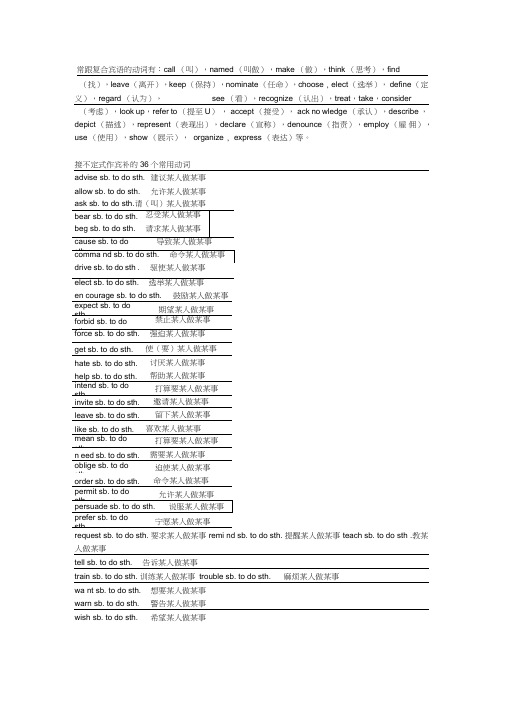
常跟复合宾语的动词有:call (叫),named (叫做),make (做),think (思考),find (找),leave (离开),keep (保持),nominate (任命),choose , elect (选举),define (定义),regard (认为),see (看),recognize (认出),treat,take,consider(考虑),look up,refer to (提至U),accept (接受),ack no wledge (承认),describe ,depict (描述),represent (表现出),declare (宣称),denounce (指责),employ (雇佣),use (使用),show (展示),organize , express (表达)等。
接不定式作宾补的36个常用动词advise sb. to do sth. 建议某人做某事allow sb. to do sth. 允许某人做某事request sb. to do sth. 要求某人做某事remi nd sb. to do sth. 提醒某人做某事teach sb. to do sth .教某人做某事tell sb. to do sth. 告诉某人做某事train sb. to do sth. 训练某人做某事trouble sb. to do sth. 麻烦某人做某事wa nt sb. to do sth. 想要某人做某事warn sb. to do sth. 警告某人做某事wish sb. to do sth. 希望某人做某事汉语的"原谅某人做某事”,英语可说成excuse [forgive] sb. for doi ng sth.不带to的不定式作宾补动词不定式在使役动词( make , let, have )或感官动词(feel , listen to , hear, look at , see , watch , notice )之后作宾补时不定式需省去to。
英语宾补结构

英语中的宾补结构指的是在句子中,主语和宾语之间通过一个补语来进一步补充说明宾语的状态或身份。
常见的宾补结构包括以下几种:
1.动词+宾语+形容词:例如,“She painted the house blue.”(她把房子涂
成蓝色。
)其中,“blue”是形容词,作宾补,描述了宾语“房子”的颜色。
2.动词+宾语+名词:例如,“They elected him president.”(他们选举他为总
统。
)其中,“president”是名词,作宾补,描述了宾语“他”的身份。
3.动词+宾语+副词:例如,“They left the party early.”(他们早早离开了聚
会。
)其中,“early”是副词,作宾补,描述了宾语“他们”离开的时间。
4.动词+宾语+不定式:例如,“I want to make you happy.”(我想让你开心。
)
其中,“to make you happy”是不定式短语,作宾补,描述了宾语“你”的感受。
5.动词+宾语+分词:例如,“He heard his name called.”(他听到有人叫他
的名字。
)其中,“called”是分词,作宾补,描述了宾语“他的名字”的状态。
不同的动词和不同的宾语之间可能存在不同的搭配方式,具体的用法需要根据语境来确定。
动词宾语宾补
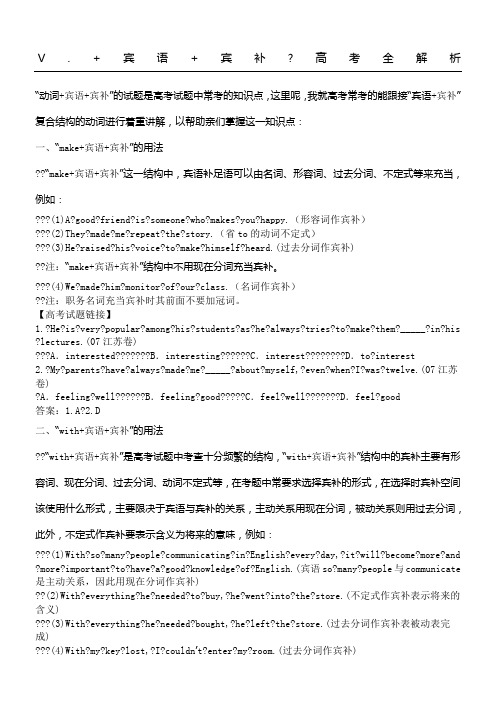
V.+宾语+宾补?高考全解析“动词+宾语+宾补”的试题是高考试题中常考的知识点,这里呢,我就高考常考的能跟接“宾语+宾补”复合结构的动词进行着重讲解,以帮助亲们掌握这一知识点:一、“make+宾语+宾补”的用法“make+宾语+宾补”这一结构中,宾语补足语可以由名词、形容词、过去分词、不定式等来充当,例如:(1)A?good?friend?is?someone?who?makes?you?happy.(形容词作宾补)(2)They?made?me?repeat?the?story.(省to的动词不定式)(3)He?raised?his?voice?to?make?himself?heard.(过去分词作宾补)注:“make+宾语+宾补”结构中不用现在分词充当宾补。
(4)We?made?him?monitor?of?our?class.(名词作宾补)注:职务名词充当宾补时其前面不要加冠词。
【高考试题链接】1.?He?is?very?popular?among?his?students?as?he?always?tries?to?make?them?_____?in?his lectures.(07江苏卷)A.interestedB.interestingC.interestD.to?interest2.?My?parents?have?always?made?me?_____?about?myself,?even?when?I?was?twelve.(07江苏卷)A.feeling?wellB.feeling?goodC.feel?wellD.feel?good答案:1.A?2.D二、“with+宾语+宾补”的用法“with+宾语+宾补”是高考试题中考查十分频繁的结构,“with+宾语+宾补”结构中的宾补主要有形容词、现在分词、过去分词、动词不定式等,在考题中常要求选择宾补的形式,在选择时宾补空间该使用什么形式,主要限决于宾语与宾补的关系,主动关系用现在分词,被动关系则用过去分词,此外,不定式作宾补要表示含义为将来的意味,例如:(1)With?so?many?people?communicating?in?English?every?day,?it?will?become?more?and moreimportanttohaveagoodknowledgeofEnglish.(宾语so?many?people与communicate 是主动关系,因此用现在分词作宾补)(2)With?everything?he?needed?to?buy,?he?went?into?the?store.(不定式作宾补表示将来的含义)(3)With?everything?he?needed?bought,?he?left?the?store.(过去分词作宾补表被动表完成)(4)With?my?key?lost,?I?couldn’t?enter?my?room.(过去分词作宾补)(5)Withnothingtodo,Iwentoutforawalk.(不定式作宾补)(6)I?went?out?with?the?window?open.(形容词作宾补)另外,“with+宾语+宾补”结构中还可由介词短语、副词短语来充当宾补,如:(1)She?said?good-bye?with?tears?in?her?eyes.(2)He?left?the?room?with?the?light?still?on.【高考试题链接】1.—Come?on,?please?give?me?some?ideas?about?the?project.—Sorry.?With?so?much?work?______?my?mind,?I?almost?break?down.(07福建卷) A.filledB.fillingC.to?fillD.being?filled2.?John?received?an?invitation?to?dinner,?and?with?his?work?______?he?gladly?accepted it.(07安徽卷)A.finishedB.finishingC.having?finishedD.was?finished3.?I?couldn’t?to?my?homework?with?all?the?noise______.(05北京)A.going?onB.goes?onC.went?onD.to?go?on答案:1.?B2.?A?3.?A三、“have+宾语+宾补”的用法在“have+宾语+宾补”这一结构用法中,充当宾补的常用的有do,doing,?done和adj,例如:(1)I’ll?have?my?hair?cut?this?afternoon.我今天下午要理发。
宾语和宾语补足语的区别

宾语和宾语补足语的区别宾语(Object)和宾补(Object Complement)是句子中的两个独立成分,它们在意义和语法功能上有着明显的区别。
一、宾语宾语是指动词的直接接受者,它通常回答“谁?”或“什么?”的问题。
宾语一般位于及物动词或介词之后。
例如:1. I eat an apple.(我吃了一个苹果。
)2. She loves her cat.(她爱她的猫。
)从上面的例子可以看出,宾语是动作的承受者,它是句子中的主要成分,可以是名词、代词、短语或从句。
它的作用是对主语的动作进行完善和具体化。
二、宾补宾补是对宾语进行补充说明或更进一步说明,它通常回答“如何?”或“是什么?”的问题,进一步扩展了宾语的意义。
宾补通常出现在使役动词、感官动词、使动动词或称为“静态动词”的系动词之后。
例如:1. They elected him president.(他们选举了他为总统。
)2. The teacher made the students quiet.(老师让学生保持安静。
)从上面的例子可以看出,宾补直接跟在宾语后面,对其进行补充说明。
它可以是形容词、名词、介词短语、不定式、分词等,用来补充和修饰宾语。
宾补与宾语的最主要区别在于:1. 宾补是对宾语的进一步补充或说明,它强调补充的内容与宾语之间的关系;而宾语则是动作的承受者,它更直接地接受动作。
2. 宾补的存在是为了完善宾语的意义,扩展宾语的信息;而宾语本身则是动作的指向对象。
3. 当动词的意义需要进一步说明时,用宾补;当动词的意义已经明确无需补充时,用宾语即可。
总体来说,宾补起到对宾语进行进一步说明和补充的作用,对句子的意义和信息起到了一定的拓展。
宾补和宾语在句子中扮演了不同的角色,并且具有不同的语法功能。
因此,在学习和理解句子结构和语法规则时,需要注意宾语与宾补的区别。
宾补的结构

宾补的结构宾语补足语(Object Complement,简称宾补)是英语句法中的一个重要组成部分。
它出现在某些及物动词后面,用来对宾语进行补充说明,表达宾语的动作、状态、特征或身份等。
宾补结构的基本形式如下:主语 + 谓语动词(及物动词) + 宾语 + 宾语补足语例如:1. 名词作宾补:I consider him my friend . (我认为他是我的朋友)主语:I谓语动词:consider宾语:him宾语补足语:my friend2. 形容词作宾补:She found the room empty . (她发现房间是空的)主语:She谓语动词:found宾语:the room宾语补足语:empty3. 副词作宾补:He left the door open . (他让门开着)主语:He谓语动词:left宾语:the door宾语补足语:open4. 不定式作宾补:We want you to come with us. (我们希望你和我们一起来)主语:We谓语动词:want宾语:you宾语补足语:to come5. 现在分词作宾补:The news made her excited . (这个消息使她感到兴奋)主语:The news谓语动词:made宾语:her宾语补足语:excited6. 过去分词作宾补:They considered him a genius . (他们认为他是天才)主语:They谓语动词:considered宾语:him宾语补足语:a genius7. 介词短语作宾补:I saw a man in the park . (我看见一个人在公园里)主语:I谓语动词:saw宾语:a man宾语补足语:in the park。
“感使动词+宾语+宾语补足语”结构中“宾语补足语”的用法
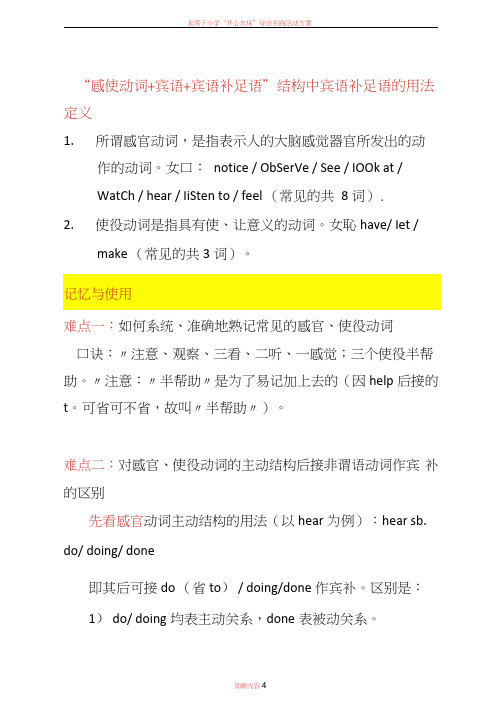
“感使动词+宾语+宾语补足语”结构中宾语补足语的用法定义1.所谓感官动词,是指表示人的大脑感觉器官所发出的动作的动词。
女口:notice / ObSerVe / See / IOOk at /WatCh / hear / IiSten to / feel (常见的共8 词).2.使役动词是指具有使、让意义的动词。
女恥have/ Iet /make (常见的共3词)。
难点一:如何系统、准确地熟记常见的感官、使役动词口诀:〃注意、观察、三看、二听、一感觉;三个使役半帮助。
〃注意:〃半帮助〃是为了易记加上去的(因help后接的t。
可省可不省,故叫〃半帮助〃)。
难点二:对感官、使役动词的主动结构后接非谓语动词作宾补的区别先看感官动词主动结构的用法(以hear为例):hear sb. do/ doing/ done即其后可接do (省to) / doing/done作宾补。
区别是:1) do/ doing均表主动关系,done表被动关系。
2 )do/ doing都可表主动,但do指整个动作,经常性动作或强调动作完成了。
doing指动作正在进行或动作的某个片断。
3) done指某事由别人做(被做),也作〃遭受〃解。
试比较:A) I heared him Sing a song.我听他唱了一首歌(指自始至终整个过程)。
B)I heared him Singing a song.我听见他正在唱歌唱(指当时动作的某个片断)。
C)I hearedaSOng sung.我听见(有人)唱歌(逻辑主语〃歌〃与〃唱〃是被动关系。
)再看使役动词主动结构的用法:have sb. do/ doing/ done, make/let sb. do/ donehave后也接do (省to) / doing/ done作宾补,区别是:1)do/doing均表主动关系,done表被动关系。
2)do/ doing虽然都表主动,但do指目前和将来或经常性、反复性的动作。
- 1、下载文档前请自行甄别文档内容的完整性,平台不提供额外的编辑、内容补充、找答案等附加服务。
- 2、"仅部分预览"的文档,不可在线预览部分如存在完整性等问题,可反馈申请退款(可完整预览的文档不适用该条件!)。
- 3、如文档侵犯您的权益,请联系客服反馈,我们会尽快为您处理(人工客服工作时间:9:00-18:30)。
一、“make+宾语+宾补”的用法“make+宾语+宾补”这一结构中,宾语补足语可以由名词、形容词、过去分词、不定式等来充当,例如:(1) A good friend is someone who makes you happy.(形容词作宾补)(2) They made me repeat the story.(省to的动词不定式)(3) He raised his voice to make himself heard.(过去分词作宾补)注:“make+宾语+宾补”结构中不用现在分词充当宾补。
(4)We made him monitor of our class.(名词作宾补)注:职务名词充当宾补时其前面不要加冠词。
【试题链接】1. He is very popular among his students as he always tries to make them _____ in his lectures. A.interested B.interesting C.interest D.to interest2. My parents have always made me _____ about myself, even when I was twelve.A.feeling well B.feeling good C.feel well D.feel good答案:1.A 2.D二、“with+宾语+宾补”的用法“with+宾语+宾补”是高考试题中考查十分频繁的结构,“with+宾语+宾补”结构中的宾补主要有形容词、现在分词、过去分词、动词不定式等,在考题中常要求选择宾补的形式,在选择时宾补空间该使用什么形式,主要限决于宾语与宾补的关系,主动关系用现在分词,被动关系则用过去分词,此外,不定式作宾补要表示含义为将来的意味,例如:(1) With so many people communicating in English every day, it will become more and more imp ortant to have a good knowledgeof English.(宾语so many people与communicate是主动关系,因此用现在分词作宾补)(2) With everything he needed to buy, he went into the store. (不定式作宾补表示将来的含义)(3) With everything he needed bought, he left the store. (过去分词作宾补表被动表完成)(4) With my key lost, I couldn’t enter my room. (过去分词作宾补)(5) With nothing to do, I went out for a walk. (不定式作宾补)(6) I went out with the window open. (形容词作宾补)另外,“with+宾语+宾补”结构中还可由介词短语、副词短语来充当宾补,如:(1) She said good-bye with tears in her eyes.(2) He left the room with the light still on.【试题链接】1. ----Come on, please give me some ideas about the project.----Sorry. With so much work ______ my mind, I almost break down.A.filled B.filling C.to fill D.being filled2. John received an invitation to dinner, and with his work ______ he gladly accepted it. A.finished B.finishing C.having finished D.was finished3. I couldn’t to my homework with all the noise______.A.going on B.goes on C.went on D.to go on答案:1. B 2. A 3. A三、“have+宾语+宾补”的用法在“have+宾语+宾补”这一结构用法中,充当宾补的常用的有do,doing, done和adj,例如:(1) I’ll have my hair cut this afternoon.我今天下午要理发。
(2) I won’t have you saying to your mother that way.(3) He realized that she did not wish to have her go with him.(4) I expect Amy will have the tea ready directly.注意:have sth. done的含义为“请别人来做某事或遭遇到某到情况”,例如:(1) I had the door painted last week.(2) He had his pocket picked.(3) She had her watch stolen.【试题链接】1. Jenny hopes that Mr. Smith will suggest a good way to have her written English _____ in a short period.A.improved B.improving C.to improve D.improve2. ----Did Peter fix the computer himself?----He _____, because he doesn’t know much about computers.A.has it fixed B.had fixed it C.had it fixed D.fixed it3. You should understand the traffic rule by now. You’ve had it _____ often enou gh.A.explaining B.to explain C.explain D.explained答案:1. A 2. C 3. D四、“find+宾语+宾补”的用法“find+宾语+宾补”这一结构中的宾语补足语可以由现在分词、过去分词、名词、形容词、副词、介词短语以及不定式to be等来充当。
分别举例如下:(1) You will find it a very difficult book.(2) The youth found it a hard problem to think about.(3) When he came to himself, he found himself surrounded by a group of boys.(4) I hope to find you in better spirits when we meet again.(5) I find the Chinese people to be happy and cheerful.注意:find+宾语+宾补这一结构中通常不使用动词原形来充当宾语补足语,即没有“find+宾语+动词原形”这样的结构。
【试题链接】A cook will be immediately fired if he is found ____ in the kitchen.(03全国卷)A.smoke B.smoking C.to smoke D.smoked答案:B。
五、“leave+宾语+宾补”的用法Leave+宾语+宾语补足语,其中宾语补足这一成分可以由过去分词、现在分词、形容词、介词的复合结构等来充当,分述如下:1. 由过去分词来充当宾语补足语:leave sth/sb done,常用来表示宾语所处的状态或表示动作已经完成。
(1) Please excuse me if I have left any of your questions unanswered.(2) He got up slowly leaving the lunch unfinished.(3) Did you leave the doors and windows firmly fastened?△可用于被动语态:Hi!My patient can’t be left unattach ed.2. 由现在分词来充当宾语补足语:leave sb/sth doing,常用来表示使某人或某物一直做某事:(1) Don’t leave her waiting outside in the rain.(2) They went off together and left me sitting there.(3) We left him painting the gate.△可用于被动语态:Now the temple has only its walls left standing.The papers were left lying around.3. 由形容词来充当宾语补足语:(1) You’d better leave the drawing-room door open.(2) His illness has left him weak.△可用于被动语态:The window was left open.4. 由介词的复合结构充当宾语补足语:(1) Leave him in peace!(2) His illness left him with a weak heart.(3) You’ve left her name off the list.△可用于被动语态:I was left without a ray of hope.【试题链接】A good story does not necessarily have to have a happy ending, but the reader must not be left______. A.unsatisfied B.unsatisfying C.to be unsatisfying D.being unsatisfied答案:A六、“hear+宾语+宾补”的用法“hear+宾语+宾补”这一结构中的宾补常可以由现在分词、不带to的不定式、过去分词等来充当,如:Through the wall he could hear Harris cleaning his teeth.She could hear the rain pattering against the windows.Have you ever heard a pop song sung in Japanese?I won’t hear anything said against him behind his back.【试题链接】After a knock at the door, the child heard his mother’s voice _____ him.A.calling B.called C.being called D.to call答案:A。
